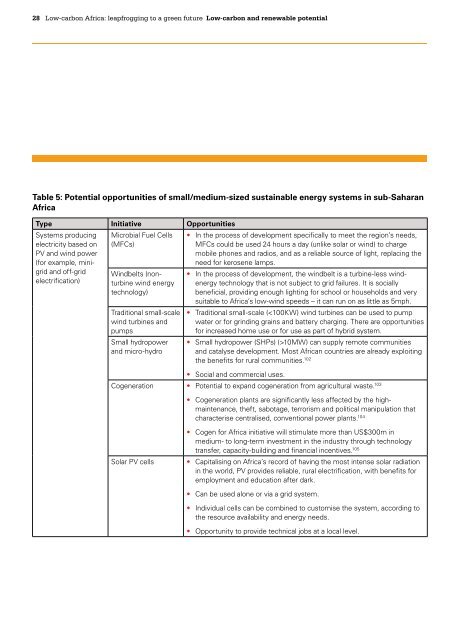Ju8uG
Ju8uG
Ju8uG
Create successful ePaper yourself
Turn your PDF publications into a flip-book with our unique Google optimized e-Paper software.
28 Low-carbon Africa: leapfrogging to a green future Low-carbon and renewable potential<br />
Table 5: Potential opportunities of small/medium-sized sustainable energy systems in sub-Saharan<br />
Africa<br />
Type Initiative Opportunities<br />
Systems producing<br />
electricity based on<br />
PV and wind power<br />
(for example, minigrid<br />
and off-grid<br />
electrification)<br />
Microbial Fuel Cells<br />
(MFCs)<br />
Windbelts (nonturbine<br />
wind energy<br />
technology)<br />
Traditional small-scale<br />
wind turbines and<br />
pumps<br />
Small hydropower<br />
and micro-hydro<br />
• In the process of development specifically to meet the region’s needs,<br />
MFCs could be used 24 hours a day (unlike solar or wind) to charge<br />
mobile phones and radios, and as a reliable source of light, replacing the<br />
need for kerosene lamps.<br />
• In the process of development, the windbelt is a turbine-less windenergy<br />
technology that is not subject to grid failures. It is socially<br />
beneficial, providing enough lighting for school or households and very<br />
suitable to Africa’s low-wind speeds – it can run on as little as 5mph.<br />
• Traditional small-scale (10MW) can supply remote communities<br />
and catalyse development. Most African countries are already exploiting<br />
the benefits for rural communities. 102<br />
• Social and commercial uses.<br />
Cogeneration • Potential to expand cogeneration from agricultural waste. 103<br />
Solar PV cells<br />
• Cogeneration plants are significantly less affected by the highmaintenance,<br />
theft, sabotage, terrorism and political manipulation that<br />
characterise centralised, conventional power plants. 104<br />
• Cogen for Africa initiative will stimulate more than US$300m in<br />
medium- to long-term investment in the industry through technology<br />
transfer, capacity-building and financial incentives. 105<br />
• Capitalising on Africa’s record of having the most intense solar radiation<br />
in the world, PV provides reliable, rural electrification, with benefits for<br />
employment and education after dark.<br />
• Can be used alone or via a grid system.<br />
• Individual cells can be combined to customise the system, according to<br />
the resource availability and energy needs.<br />
• Opportunity to provide technical jobs at a local level.


